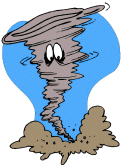
Tornadoes
 A rapidly spiralling column of air is called a tornado or twister. They are very rare in Britain and Europe, but occur commonly each spring and summer in the centre of the United States. Here, large thunderstorms develop because there is an awful lot of energy stored in the atmosphere. Some large thunderstorms give birth to tornadoes.
A rapidly spiralling column of air is called a tornado or twister. They are very rare in Britain and Europe, but occur commonly each spring and summer in the centre of the United States. Here, large thunderstorms develop because there is an awful lot of energy stored in the atmosphere. Some large thunderstorms give birth to tornadoes.
The tornado is usually very small in comparison to the thunderstorm, perhaps only several tens of metres wide, but it can wreak terrible havoc across the small area over which it moves. At a distance, a tornado is seen as a rapidly rotating funnel or spout of air, usually coloured grey because of clouds and Earth debris caught up inside it. The strongest tornadoes can have wind speeds of over 250 mph and sometimes over 300 mph.
Websites
Other topics Technical Page
Technical Page
• Wild Weather Page
• Chain Reaction
• Tornadoes
• Franklin Institute
• Introduction to Weather
• Clouds
• Dew
• Energy
• Fog
• Forecasting
• Hurricanes
• Measuring Weather
• Thunderstorms
• Tornadoes
• Water Cycle
 Print Topic
Print Topic